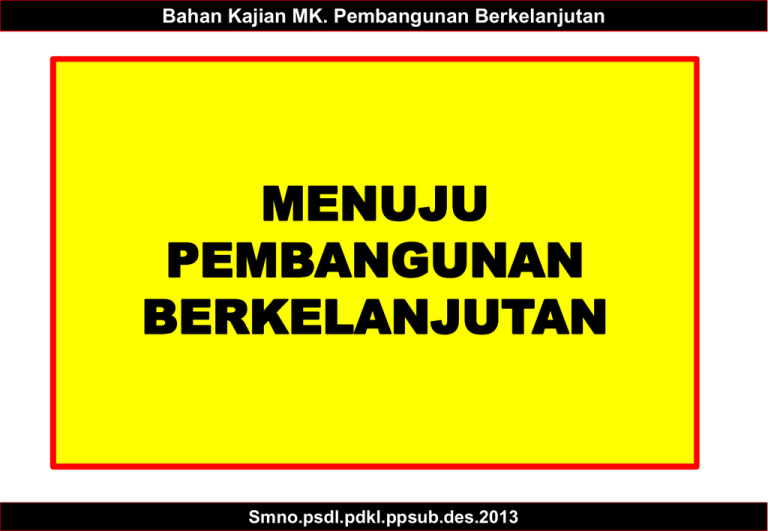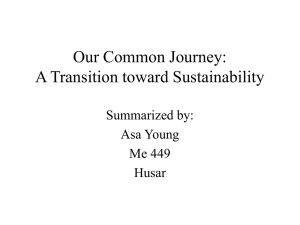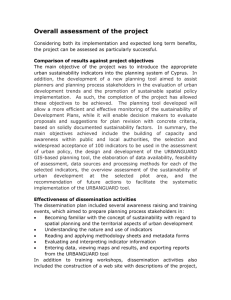Principles of sustainable development
advertisement

Bahan Kajian MK. Pembangunan Berkelanjutan MENUJU PEMBANGUNAN BERKELANJUTAN Smno.psdl.pdkl.ppsub.des.2013 Sustainable Development Hierarchical system A four-tier system was adopted for the evaluation of sustainable development within the community. Its components were: 1. 2. 3. 4. Principles of sustainable development; Criteria of sustainable development; Indicators derived from criteria; Verifiers to measure specific strategic actions, whose qualitative or quantitative values allow comparison of results over time. The next step was to identify the principles, criteria, indicators and verifiers covering the following three areas of evaluation: socioeconomics; ecology and the environment; and community culture and self-management. Each of these three areas has its own respective principles of sustainability, just as each principle has its own criteria, each of which has its indicators and, lastly, its relevant verifiers. A principle provides the framework for sustainable forest development. It constitutes a fundamental law or truth as the basis for a rationale or action, and provides the justification for the criteria, indicators and verifiers generated . For the purposes of the study, a principle was considered an achievable goal in the social and ecological process of sustainable development. The hierarchical system in the evaluation model comprised the following basic principles of sustainability. Externalities are common in virtually every area of Principle 1: Respect and concern for community life favour sustainable development. economic activity. They are defined as third party (or spillover) effects arising from the production and/or consumption of goods and services for which no appropriate compensation is paid. This is an ethical principle. It means that development should not take place to the detriment of other external groups not linked to the community in question. http://tutor2u.net/economics/content/topics/externalities/what_are_externalities .htm Principle 2: The harmonious development of people, natural resources and the environment is what sustains the quality of human life. What is really demanded of development is that it better the quality of people's lives. Economic growth is an important component of development, but cannot be a goal in itself. Sustainable development is only real if it makes the life of the community better in every sense. In fact, given our stated goals, the only formulations of even tentative interest are those depicted by the blue points. These are the Pareto-optimal points, which together make up the Pareto front, named after Italian economist Vilfredo Pareto. The points on the Pareto front are said to dominate the other points. https://community.accelrys.com/community/accelrys_blog/blog/201 0/06/02/pareto-optimization Principle 3: Sub-objectives associated with the community objective of resource conservation and their associated importance scores. Conservation and protection of biodiversity and the environment favour sustainable development. Conservation-based development necessarily includes deliberate action to protect the structure, functions and diversity of ecosystems and of the environment. http://www.ecologyandsociety.org/vol5/iss2/art24/ Principle 4: Forest ecosystem management must not exceed the capacity of the ecosystem. The limits of ecosystem functioning vary from one ecosystem to another. Policies need to bring the number of people and their livelihoods into balance with the capacity of the ecosystem. This capacity must be developed through careful management designed to provide quality goods and services in a sustainable way. Furthermore, the continuous interaction among people, natural resources and the environment must be managed to cause the least possible damage to the ecosystem. Principle 5: Interaction of the human social system with the ecosystem The culture of the community must be in line with sustainable development. People need to reexamine their values and behaviour. The community should promote values that support the new ethics, and do away with those incompatible with a sustainable way of life. http://gerrymarten.com/human-ecology/chapter01.html Principle 6: Five Modalities Model of Community Development Community selfmanagement and ownership are fundamental for sustainable development. Properly informed, motivated, committed and responsible communities can and must contribute to the decisions affecting them and play a crucial role in sustainable development http://tedshelton.blogspot.com/2010/11/five-modalities-model-ofcommunity.html www.fao.org/docrep/006/y5189e/y5189 e05.htm 11 Sustainable State Project 1. Joint project between Local government and State Government 2. Creates goals and indicators to identify and track important sustainability issues 3. Integrates academic, private sector, governmental and citizen expertise 4. Links government programs to ensure implementation 5. Broad Target Audience - accessible and informative to all New Jerseyans 6. Comprehensive - covering economy, environment, and society New Jersey Future 1. 14 year-old nonprofit organization 2. Work with government and business 3. Designed NJ’s Sustainable State goals and indicators process 4. Develop and advocate solutions to NJ’s sustainable development and land use issues regulatory compliance 13 The risk management approach allows companies to save money by anticipating and avoiding expenditures arising from environmental damage, and by minimizing the cost of complying with future legislation. In addition, operating costs can be reduced through waste minimization, pollution prevention and the elimination of health & safety hazards. 14 Netherlands Green Plan 1. To achieve sustainability in one generation 2. Sets measurable goals 3. Tracks progress toward meeting goals 4. Utilizes integrated planning, across governments, departments and industry sectors, to achieve the goals 5. Widely recognized and supported by citizens What Did We Learn? Seeing Things Differently Is The First Step Toward Doing Things Differently Without Clear Goals for the Future, and a System to Track Progress, You are Just Spinning Your Wheels 16 www.bsdglobal.com/sd_journey.asp www.oag-bvg.gc.ca/.../att_c907xe01_e_10106.html Sustainable business strategies Business strategies for sustainable development mark the final phase in the journey. The aim is to seek win-win situations which can achieve environmental quality, increase wealth, and enhance competitive advantage. Companies integrate sustainable development into their business strategies. Sustainable development is a natural extension of many corporate environmental policies. In the pursuit of economic, environmental and community benefits, management considers the long-term interests and needs of the stakeholders. Sustainable business strategies Sustainable development strategies uncover business opportunities in issues which, in earlier stages of the journey, might be regarded as costs to be borne or risks to be mitigated. Results include new business processes with reduced external impacts, improved financial performance, and an enhanced reputation among communities and stakeholders. For the business enterprise, sustainable development means adopting strategies and activities that meet the needs of the enterprise and its stakeholders today while protecting, sustaining and enhancing the human and natural resources that will be needed in the future. Sustainable development and environmental protection compared Similarities: By protecting the environment we support sustainable development. A healthy environment means clean air, unpolluted water and healthy soil, which are necessary for the survival of future generations. The preservation of natural resources supports sustainability. Many environmental concepts like reuse and recycling allow us to save natural resources for future generations. Environmental training and education support sustainable development. While working to protect the environment we learn more about the world around us and improve our ability to identify solutions for sustainable development. 20 Sustainable development and environmental protection compared Differences: Environment is just one of the components embedded in the concept of sustainable development. Society and economy are equally important. Although it is necessary to protect the environment it is not always sufficient, since a healthy environment does not necessary mean a prosperous society or a healthy economy. Sustainable development is a goal of the entire society. Thus a participatory approach is an integral part of sustainability Sustainable development explores the relationships between environmental, social and economic benefits. Environmental protection is often limited to the impact on nature. Environmental protection implies reducing adverse effects, not necessarily allowing future generations to inherit the same amount of natural, social and economic wealth as their predecessors. Whereas environmental protection is often regulated, sustainable development involves going beyond compliance. 21 Creating Goals & Indicators • • • • • • NJ Leaders Create Draft Goals NJ academics and experts create draft indicators Large Statewide Forums, Small Regional and Topical Forums State agency review Diverse review committee Third Sustainable State Conference Release Goals & Indicators www.eolss.com/eolss/5a.htm “Sustainable development” is development that will “... meet the needs of the present without compromising the ability of future generations to meet their own needs.” Definition from the 1987 Brundtland Commission (The World Commission on Environment and Development) www.rice.re/presen2.htm A Sustainable State This symbol represents what a Sustainable State would look like. Each of the three rings, economy, environment and society, is a system that we rely on to support us. Unless all three are functioning and healthy, we will not be sustainable. You canít pull on one, to the exclusion of the others. Sustainable State Goals 1. Economic Vitality 2. Equity 3. Strong Community, Culture & Recreation 4. Quality Education 5. Good Government 6. Decent Housing 7. Healthy People 1. Efficient Transportation & Land Use 2. Natural & Ecological Integrity 3. Protected Natural Resources 4. Minimal Pollution & Waste GOAL: Economic Vitality An economy that is competitive, diverse and attractive to business; that maintains and expands assets and capital; that provides a variety of entry-, middle- and high-level jobs; and that promotes the well-being of New Jersey’s communities and its workforce. GOAL: Economic Vitality 1. 2. 3. 4. 5. 6. Income Unemployment Productivity Poverty GSP Energy efficiency. Sustainable Development with reference to Different forms of Capital 27 GOAL: Efficient Transportation & Land Use A choice of efficient, convenient, safe and affordable transportation and land use options, providing access to jobs, shopping, recreational centers, schools, airports and rail centers. This Goal, for Efficient Transportation and Land Use, is obviously key to the success and future of New Jersey businesses. www.sectur.gob.mx/wb/secturing/sect_ing_desti... GOAL: Efficient Transportation & Land Use 1. Need for road and bridge repairs 2. Vehicle miles traveled 3. Workplace transportation options 4. Traffic fatalities www.suzlonfoundation.org/program _framework.html 29 GOAL: Protected Natural Resources The complex interactions among the different dimensions of sustainable development www.eolss.com/eolss/5a.htm GOAL: Protected Natural Resources 1. Energy consumption 2. Farmland 3. Beach and bay closings 4. Preserved and developed land. The six major systems of the anthroposphere and their major relationships. These six sector systems can be aggregated to the three subsystems: Human System, Built System (Human Engineered System) and Natural System. 31 32 ejournal.nbii.org/archives/vol3iss1/0602-007.... GOAL: Minimal Pollution & Waste Minimize the generation and accumulation of pollution and waste; maximize the use of efficient, clean and sustainable energy sources; and increase consumer choices for ecologically friendly products. www.wasteawarecampus.org.uk/hierarchy.asp GOAL: Minimal Pollution & Waste 1. Greenhouse gas releases 2. Drinking water quality 3. Solid waste production 4. Air pollution www.davidkrohn.net/ Solid Waste Production 35 Other Indicators 1. Mortality (Life Expectancy) 2. Infectious Diseases 3. Housing Affordability 4. Wage Equality 5. Voter Turnout 6. Knowledge of Government 7. Standardized Test Scores. An understanding of the sustainability of the natural system lies at the confluence of many disciplines 36 Where Are We Now? 1. “Living With The Future in Mind II” Released With Targets 2. Nearly 20,000 Copies of I & II Distributed 3. Executive Order #96 Signed 4. State Government Begins Implementation 5. Businesses and NGO begin Implementation 6. Transition and Planning for Institutionalization All State Agencies and Departments Shall: 1. Pursue policies which comport with the 11 sustainability goals. 2. Establish institutional mechanisms, and collaborate in the exchange of information, to facilitate the achievement of these goals. 3. Report to the Governor, and every year thereafter, on their progress toward goal attainment. SUSTAINABILITY GOALS SUSTAINABILITY INDICATORS AND TARGETS PROGRAMS AND OPERATIONS (Performance Measures) Menuju pembangunan berkelanjutan NJDEP Implementation 1. 2. 3. 4. Strategic Planning and NEPPS Sustainability “Lens” and Assessment Silver and Gold Track NJ/Netherlands “Aide Memoire” on Global Warming 5. Linking Targets and Programs (e.g. Greenhouse Gas Action Plan) II. N J’s RE SU LT S-B AS ED MA NA GE ME NT SY ST EM • S o c ie t y PLAN Su stain able St ate ADAPT • E n v ir o n m e n t • E co n o m y DO CHECK D E P M i s s io n D E P S tr a te g ic P la n N E P P S * P e r f o r m a n c e P a r t n e r s h ip A g r e e m e n t P r o g r a m W o r k P la n s /B u d g e t * N E P P S = N a tio n a l E n vi ro n m e n t a l P e rf o rm a n c e P a rtn e rsh ip S ys t e m - In c lu d e s re p o rtin g o n 9 g o a ls & o ve r 1 0 0 in d ica to rs 41 Other Departments and Agencies 1. Higher Education Capital Fund (Education) 2. Budget Guidelines for Sustainability (Management and Budget) 3. Sustainable Housing Program (Community Affairs) 4. Indicator Tracking (All Agencies) 5. Interagency Work Group on Sustainable Development - “Governing With The Future In Mind” (All Agencies) Where Are We Now? 1. “Living With The Future in Mind ” Released With Targets 2. State Government Begins Implementation 3. Businesses and NGO begin Implementation 4. Transition and Planning for Institutionalization Business Implementation 1. 2. 3. 4. Participation in Silver Track Corporate Responsibility NJ Sustainable Business Alliance Self Assessment and Corporate Sustainability Reports 5. Sustainability “Seal of Approval” 6. Participants and Watchdogs NGO Implementation • Participants and Watchdogs • Local Partners and Mimics Morris 2000, Hunterdon 2020, Passaic Tomorrow • NGO Partners ANJEC, NJ Future, NJHEPS, Affordable Housing Network 45 Transition and Institutionalization 1. Institutionalize the goals and indicators inside and outside of government 2. Work with the business community to adopt and implement the goals 3. Work with local government and communities to “nest” goals and indicators INSTITUSIONALISASI 2001 and Beyond NON-GOVERNMENT GOVERNMENT Permanent Non-governmental Home Permanent Governmental Home Citizen Participation Strategic Planning Living with the Future in Mind Governing With the Future In Mind • Research • Benchmarks • Credibility • Broad Outreach • Stability • Broad Scope • Implementation Transisi & Institusionalisasi 1. Institutionalize the goals and indicators inside and outside of government 2. Work with the business community to adopt and implement the goals 3. Work with local government and communities to “nest” goals and indicators Jalan menuju cita-cita & tujuan pembangunan Transisi & Institutionalisasi 1. Institutionalize the goals and indicators inside and outside of government 2. Work with the business community to adopt and implement the goals 3. Work with local government and communities to “nest” goals and indicators State Goals Local Goals State Indicators Local Indicators State Plans & Operations Local Plans & Operations








